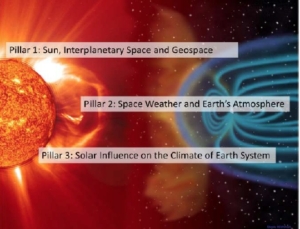The Sun is a variable star and its variability influences the Earth’s space environment. Furthermore, changing solar magnetic fields, radiative and energetic particle fluxes force the Earth’s atmosphere and climate. Transient energetic events such as flares, coronal mass ejections (CMEs), interplanetary shocks, stream interaction regions (SIRs), corotating interaction regions (CIRs) and energetic particles adversely impact critical technologies based in space and on Earth that our society is increasingly dependent upon.
At the same time, the middle and upper atmosphere/ionosphere are impacted by processes originating at lower altitudes, e.g., by atmospheric gravity waves, tides and planetary waves and changes in radiatively active gases.
Solar influence on climate is gaining increasing attention since variations in solar activity do not only impact middle atmosphere chemistry and physics, but have been shown to impact decadal variability at the Earth’s surface. This is particularly interesting and important for decadal climate predictions.
With the enhanced understanding of causal connections in the Sun-Earth system maturing over the last several decades, fueled by both observations and theoretical modelling, we are in the position to transform this understanding to improved predictions of the Sun-Earth coupled system, which is of relevance to the society and is the focus of the current PRESTO program.
PRESTO is comprised of 3 pillars:
- Pillar 1: Sun, Interplanetary Space and Geospace
- Pillar 2: Space Weather and the Earth’s Atmosphere
- Pillar 3: Solar Activity and Its Influence on the Climate of the Earth System.
The PRESTO Science Program is featured in:
Gopalswamy & Daglis, 2019, Taikong No. 13
Daglis et al. 2021, Annales Geophysicae, 39, 1013–1035
